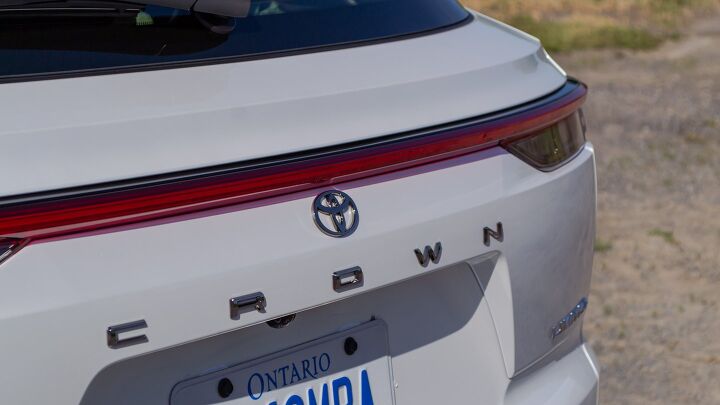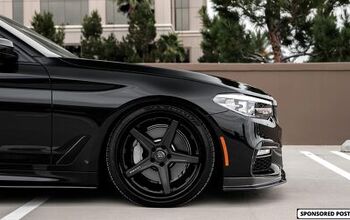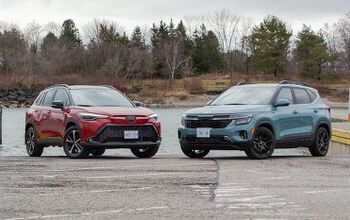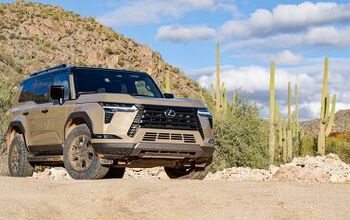2025 Toyota Crown Signia First Drive Review: Call Me Camry Cross

With the 2025 Crown Signia, Toyota is hoping the third time’s the charm.
First was the original Venza, a vehicle arguably ahead of its time. It sold fine for a few years—and strangely well in Canada, where it continued on for a few years after America had its fill. Then came along Venza 2.0, a sort of artsy RAV4 with standard hybrid power.
For 2025, Toyota is ditching that name and expanding the Crown family into the mid-sized SUV segment. The Signia is right-sized for the task, offering buyers the sort of versatility they need paired with excellent fuel efficiency and tidy road manners.
2025 Toyota Crown Signia Quick Take
The 2025 Toyota Crown Signia goes after the Subaru Outback by following its wagon-like approach to the mid-sized SUV market. This is a smoother, more urbane long-roof choice, with the standard hybrid powertrain still a relative rarity in the segment. The problem? We’re not sure it has the right name…
What’s New for 2025:
The Signia is a whole new product for this year. Sitting on the venerable TNGA-K platform, it’s a much larger vehicle than the related Venza, stretching 7.5 inches (191 millimeters) longer for a total length of 194.1 inches (4,930 mm). It’s about an inch (25 mm) wider too, yet the roof is two inches (51 mm) lower. With the same long, 112.2-inch (2,850-mm) wheelbase as the Crown sedan, the Signia is left with much different proportions than the model it is replacing. (Toyota has confirmed that while the Venza will sell alongside its newer sibling for the remainder of this year, it will not see model year 2025.)
Exterior Style:
Long, low, and wide: the Crown Signia makes great use of Toyota’s latest design language, the “hammerhead” face following the thin-lighting trend while being distinctly Toyota. The fade-in effect of the lower intake is something we’ve seen before on the latest RX, lending the Signia an upper-class feel. Toyota has kept the surfacing clean along the flanks, adding gloss black along the lower edges and wheel arches to visually lengthen the body. Furthering the wagon vibes is the long glasshouse, which provides the win-win results of better visibility and added natural light for rear-seat passengers. Buyers get about an extra inch of ground clearance over Crown sedan, totalling 6.7 inches (170 mm).
The rear employs that most 2020s of styling cues: a full-width taillight. To my eyes, this is the Signia’s weakest angle: it’s not bad, it’s just not distinctive, looking like an AI-generated amalgam of various SUVs out there. Maybe that’s why Toyota put the name in big letters across the tailgate. Note you won’t find “Signia” anywhere on the vehicle itself: that’s by design, as a Toyota spokesperson explains the brand wants to emphasize the nameplate that only recently returned to these shores.
Rolling stock consists of 19-inch wheels on the XLE, while the top trim Limited—the only trim in Canada at launch—rolls on enormous 21s. They’re very pretty, but the winter tire situation is going to be hard to deal with for Canucks. At the launch event there was no plan to bring the smaller 19s North.
Powertrain and Fuel Economy: Dual powers
As of now, every Toyota offering other than the Corolla and body-on-frame models offers some variation of this 2.5-liter hybrid all-wheel drive powertrain. The pair of electric motors produce nearly that on their own: the front unit makes 180 hp and 199 pound-feet of torque, while the rear kicks in 58 hp and 89 lb-ft. The engines pull from a small nickel metal-hydride battery pack located under the rear seats. Meanwhile, the ICE component produces 188 hp and 178 lb-ft. Toyota expects fuel economy to hit a 38 mpg (6.2 L/100 km) combined figure.
I was lucky enough to drive the Signia on two separate events: the launch event in southern California as well as AJAC’s EcoRun up in Quebec, Canada, where I delivered the car from Toyota’s head office outside Toronto. The 350-mile (567-kilometer) drive gave plenty of opportunity to get to stretch the Signia’s legs. Like most of Toyota’s modern hybrid setups, it’s responsive and eager around town, and juuuust about acceptable for keeping up with traffic on pure electrons, which can last for a few blocks at a time. There’s no physical connection from the ICE to the rear wheels, so electronic all-wheel drive only kicks in on take-offs and low-grip situations, the latter of which are in short supply on my drives. Otherwise the Signia is front-drive, which is par for the course for most models in this segment. The e-CVT does a good job harnessing the meat of the 2.5’s power band, while delivering less drone than earlier iterations of this setup. Based on the ol’ butt-dyno, this is at least as quick as an Outback turbo.
Fuel economy is of course a strength. Even on the long highway stint for EcoRun, the Crown just about matched its combined figure. Once on slower country roads, it happily crested 40 mpg (5.9 L/100 km), and that’s before the assembled journos started trying to be extra efficient.
Handling and Drivability: Well-Mannered Wagon
Toyota has tinkered and tweaked the TNGA platform for about a decade now, resulting in a well-adjusted setup that manages the dual responsibilities of comfort and (relative) engagement. The Signia isn’t going to fool anybody into thinking it’s an overgrown GR Corolla—because that isn’t the point—but the front-end is responsive and tracks true. Steering is typical Toyota: light and quick, with little resistance but a consistent feel from lock to lock and little play on-center. The low overall height has a knock-on effect for the Toyota mid-sizer’s center of gravity too, so it never feels wallowy on undulating tarmac.
Over the more entertaining squiggles of tarmac outside Montreal, the Crown is composed, even feeling a little smaller than it actually is.
Ride Quality and Comfort:
I expect a harsher edge to bumps care of those enormous 21-inch alloys, but both Crown Signia trims take the sting out, only a muffled thud making its way to the cabin. Even the pockmarked roads outside of Beloeil fail to contribute more than a dull hum, the Signia’s sound insulation keeping passengers protected from the din. There are no adaptive dampers here, just a well-judged suspension. The Signia exhibits reasonable levels of body roll for something of this class, dropping right into the middle between sportier Mazda CX-50 and the laidback Outback.
Front-seat comfort is generally good: I did spend nearly six hours in the driver’s seat with only a quick lunch pit stop between, and had zero aches or numbness at my destination. The Signia does have the Crown sedan’s issue of high seat placement, mind you: I’m 5’10” and yet my hair is just grazing the headliner when the pano roof is closed.
Interior Style and Quality:
As you’d expect given the name, this is basically a Crown inside too, and the best argument for this not simply being called Camry Cross. There are soft-touch materials aplenty in here, and the brown leather interior of the Limited is swanky. I especially like the subtle variations in the leather’s color, which gives it an added air of authenticity and thus, luxury. Slivers of bronze elevate the space, too. The dashboard is dominated by the big touchscreen, with a simple design to emphasize the width. The twin-plane selection of physical buttons below is most welcome, as is the volume knob front and center—take that, Venza. Toyota’s tiny shifter takes some getting used to, but the compact nature frees up space for sizeable cupholders. The best feature? The slot-like wireless charger, which ensures any device actually stays charging.
The back seat is a suitably swell place to while away the miles. That big glass roof and large rear quarter windows let in lots of natural light, while legroom is a good—but not great— 37.1 inches (942 mm).
Toyota is proud of the extra cargo space the Signia has over Venza. It’s a nicely square space with the seats up; drop ‘em and there’s six feet of cargo floor, all mostly flat thanks to a clever extendable shelf built into the seatbacks.
Tech and Safety:
Toyota’s 12.3-inch touchscreen is standard on Signia. This is the better layout for its cars, the added screen real estate avoiding the crowding that can happen on the radio menu of the 8.0-incher. The simple menu structure and quick responses earn it points; the added pokes to flit between (wireless) Apple CarPlay and the native setup along with the roundabout way to handle trip recordings dock ‘em. An over-the-air update should fix the former by always keeping the main menu on screen. Toyota’s audio assistant is fine, but can be tardy in responses.
Toyota Safety Sense 3.0 is standard on the Crown Signia. Automated emergency braking, full-range adaptive cruise control, blind spot monitoring—you name it, it’s here, all without extra cost. Most of it all works without issue. I still don’t love Toyota’s Proactive Driving Assist (PDA), which adjusts the speed of the car even around town out of abundance of caution, but it can be switched off. Same goes for the over-eager driver attention alert, which flares up even as I’m just swapping between navigation and audio menus on the touchscreen. Which maybe says more about modern infotainment than anything else…
Value Dollars and Sense:
American buyers can get into the new Crown Signia starting at $44,985 (including destination) for the XLE model. The swankier Limited is a comparative good value at $49,385, with the premium cabin materials and those pretty alloys. An Advanced Technology Package ($1,865) adds the 360-degree camera, Traffic Jam Assist, front cross-traffic alert, power-folding mirrors, lane change assist, and parking sensors.
In Canada, buyers can spec the Limited ($59,380 CAD) with that same package for $2,075 CAD.
That’s a little over 10-percent more than the Venza, trim-for-trim, but the Crown offers buyers a space that is both larger and prettier. The Outback range tops out where the Crown Signia’s starts though, so you’re paying a lot for that premium feel. If the Signia came with the sedan’s optional Hybrid Max powertrain, it’d go some way to justifying that hefty price.
Final Thoughts: 2025 Toyota Crown Signia First Drive Review
Personally, I’m happy Toyota is leaning into wagons again, even if it won’t call the 2025 Crown Signia one. In fact, attaching the name of a flagship sedan to an SUV that’s only in the middle of a vast high-rider lineup is an odd one: this isn’t a flagship SUV, after all. Nonetheless, it is a smooth operator, and if you’ve been yearning for the return of a Camry wagon, one with an upmarket interior, sharp looks, and a fuel-sipping AWD powertrain, well congrats: one exists now.
Become an AutoGuide insider. Get the latest from the automotive world first by subscribing to our newsletter here.
Pros | Cons |
|---|---|
Comfy ride | Pricey |
Standard hybrid powertrain | No Hybrid Max |
It's basically a wagon | Headroom isn't great |
2025 Toyota Crown Signia | |
|---|---|
Engine: | 2.5L w/ hybrid |
Outputs: | 240 hp, 178 lb-ft |
Transmission: | e-CVT, AWD |
US Fuel Economy (mpg): | 39/37/38 |
CAN Fuel Economy (L/100 km): | 6.0/6.4/6.2 |
Starting Price (USD): | $44,985 (inc. dest.) |
As-Tested Price (USD): | $51,250 (inc. dest.) |
Starting Price (CAD): | $59,380 (inc. dest.) |
As-Tested Price (CAD): | $61,455 (inc. dest.) |

Kyle began his automotive obsession before he even started school, courtesy of a remote control Porsche and various LEGO sets. He later studied advertising and graphic design at Humber College, which led him to writing about cars (both real and digital). He is now a proud member of the Automobile Journalists Association of Canada (AJAC), where he was the Journalist of the Year runner-up for 2021.
More by Kyle Patrick









































Comments
Join the conversation
Seems to be a slightly modified Lexus RX 350h. Considerably lower price however, about $8,000 less.